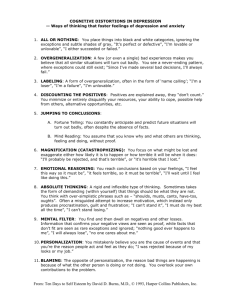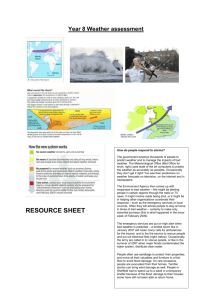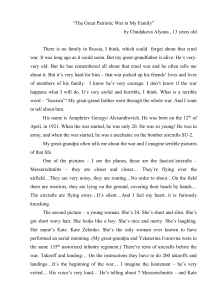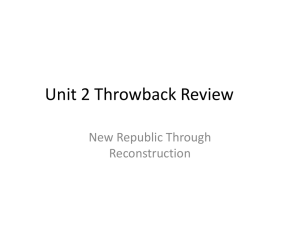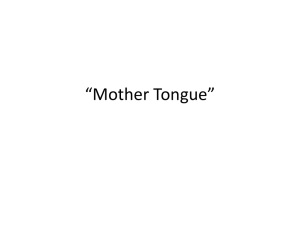Syllabus - Saint Mary`s College of California
advertisement
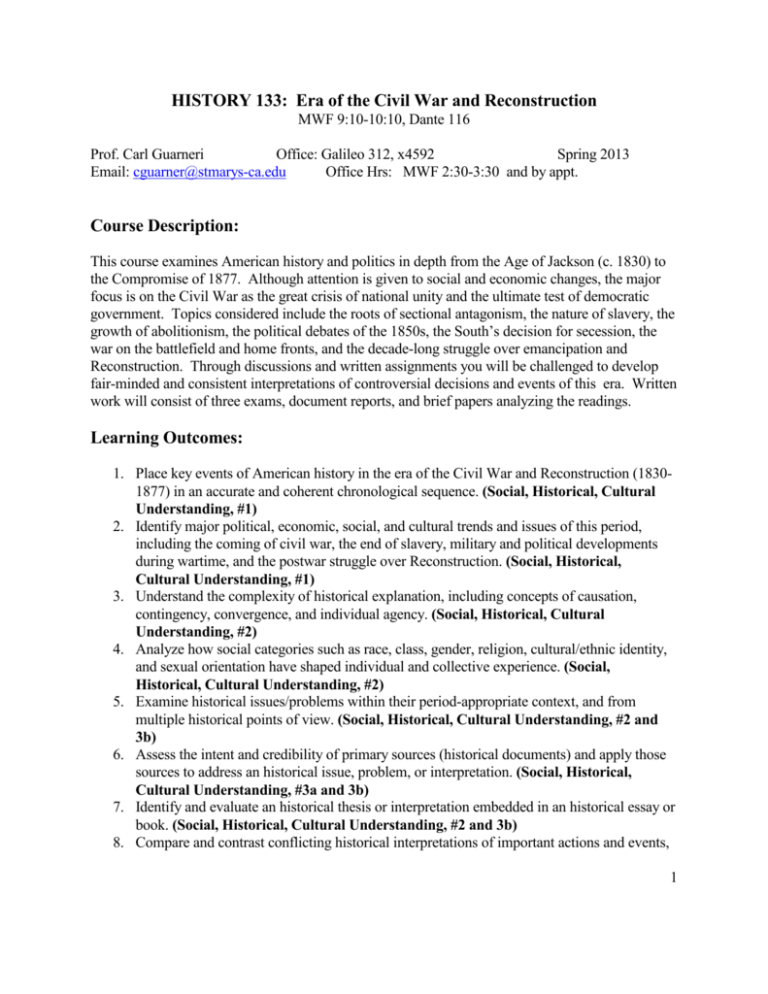
HISTORY 133: Era of the Civil War and Reconstruction MWF 9:10-10:10, Dante 116 Prof. Carl Guarneri Office: Galileo 312, x4592 Spring 2013 Email: cguarner@stmarys-ca.edu Office Hrs: MWF 2:30-3:30 and by appt. Course Description: This course examines American history and politics in depth from the Age of Jackson (c. 1830) to the Compromise of 1877. Although attention is given to social and economic changes, the major focus is on the Civil War as the great crisis of national unity and the ultimate test of democratic government. Topics considered include the roots of sectional antagonism, the nature of slavery, the growth of abolitionism, the political debates of the 1850s, the South’s decision for secession, the war on the battlefield and home fronts, and the decade-long struggle over emancipation and Reconstruction. Through discussions and written assignments you will be challenged to develop fair-minded and consistent interpretations of controversial decisions and events of this era. Written work will consist of three exams, document reports, and brief papers analyzing the readings. Learning Outcomes: 1. Place key events of American history in the era of the Civil War and Reconstruction (18301877) in an accurate and coherent chronological sequence. (Social, Historical, Cultural Understanding, #1) 2. Identify major political, economic, social, and cultural trends and issues of this period, including the coming of civil war, the end of slavery, military and political developments during wartime, and the postwar struggle over Reconstruction. (Social, Historical, Cultural Understanding, #1) 3. Understand the complexity of historical explanation, including concepts of causation, contingency, convergence, and individual agency. (Social, Historical, Cultural Understanding, #2) 4. Analyze how social categories such as race, class, gender, religion, cultural/ethnic identity, and sexual orientation have shaped individual and collective experience. (Social, Historical, Cultural Understanding, #2) 5. Examine historical issues/problems within their period-appropriate context, and from multiple historical points of view. (Social, Historical, Cultural Understanding, #2 and 3b) 6. Assess the intent and credibility of primary sources (historical documents) and apply those sources to address an historical issue, problem, or interpretation. (Social, Historical, Cultural Understanding, #3a and 3b) 7. Identify and evaluate an historical thesis or interpretation embedded in an historical essay or book. (Social, Historical, Cultural Understanding, #2 and 3b) 8. Compare and contrast conflicting historical interpretations of important actions and events, 1 and weigh their arguments and evidence. (Social, Historical, Cultural Understanding, #2 and 3b) 9. Analyze similarities and differences between popular historical genres (such as commercial films and museum displays) and scholarly historical narratives. (Social, Historical, Cultural Understanding, #2 and 3b) 10. Write persuasive and accurately documented historical essays. (Social, Historical, Cultural Understanding, #3a and 3b) Exams and Paper Assignments: Exams All exams, including the final exam, will be composed of identification questions and interpretive essays. They will not be cumulative. Study questions from which the exam material will be drawn will be distributed in class one week prior to the test dates. These exams are designed to assess your mastery of Learning Outcomes 1, 2, 3, 4, 5, 8, 10. Paper #1: Understanding the Slave Experience through Autobiographies This 5-page paper, based on the Narrative of the Life of Frederick Douglass (1845), for one half the class, and Harriet Jacobs, Incidents in the Life of a Slave Girl (1861), for the other half, analyzes the slave experience through these important document by concentrating on one of the following themes: --The variety of conditions under slavery (field work, house service, rural, urban, etc.) --The slave’s relationship with the master (and his wife) --Religion and slavery --Family relations among slaves, including the situation of women and children under slavery --Various forms of slave resistance and their quest for freedom This paper is designed to assess your mastery of Learning Outcomes #3, 4, 5, 6, 10. Paper #2: Lincoln’s Decision for Emancipation This 5-page paper asks you to interpret the complex and controversial motives and causes behind President Lincoln’s decision to issue the Emancipation Proclamation on January 1, 1863. Despite his image as the Great Emancipator, Lincoln's path to emancipation was slow and indirect, and his motives were not always easy to interpret. Was Lincoln a racial conservative who agreed only reluctantly to free the slaves as a matter of military necessity? Or had he simply been waiting for the chance to end an institution he always had viewed as immoral? What were his views of slavery and blacks? What pressures pushed Lincoln to declare emancipation, and what considerations held him back? What part did the slaves themselves play in forcing the issue? Why did Lincoln free the 2 slaves, and why at that particular time? To address these questions, you will use several important documents written by Lincoln (Simpson, ed., Think Anew, Act Anew, pp. 38, 45-46, 101-158) as well as conflicting interpretations embedded in two historical accounts (Fellman, This Terrible War, pp. 141-167; and Ira Berlin, “Who Freed the Slaves?”—reprint). This paper is designed to assess your mastery of Learning Outcomes #3, 4, 5, 6, 7, 8, 10. Paper #3: Guerrilla Warfare in the Confederate Borderlands This 5-page paper is based on the detailed account of the January 1863 massacre of Unionist sympathizers in the Appalachian region of North Carolina during the Civil War, as presented in Phillip Shaw Paludan, Victims: A True Story of the Civil War, (pp. ix-133). You will consider the following questions: --What features of society in the Appalachian region paved the way for guerrilla violence and made it seem a logical move for mountain residents? --In what ways did the Civil War come to this isolated area? Why and how were mountain residents’ loyalties divided between the Union and the Confederacy? --How did the backgrounds and experiences of the key Confederate soldiers involved (James Keith, Lawrence Allen, and Henry Heth) shape their actions in the massacre? --How do you interpret the massacre? Was it a legitimate Confederate military campaign gone awry? An assertion of community control by local Confederates over their Unionist neighbors? A logical counter-response to guerrilla warfare? A deed perpetrated by outlaws? An act of revenge outside the bounds of morality and law? Some or none of these? --Why, in your judgment, were the perpetrators of the massacre never brought to justice? This paper is designed to assess your mastery of Learning Outcomes #3, 4, 5, 6, 7, 8, 10. Film Analysis or Museum Exhibit Report: This 3- page analysis requires you to watch a commercial film about the Civil War, such as “Gettysburg” or “Lincoln,” or to visit a Civil War museum exhibit (Fort Point, Benecia Arsenal, Oakland Museum), then to describe and evaluate its presentation of Civil War events and themes, including its strengths and weaknesses as compared to a scholarly account. This report is designed to assess your mastery of Learning Outcomes #3, 5, 6, 7, 9. Document Report: This three-page paper and oral report requires you to select a primary source from the collection, Major Problems in the Civil War and Reconstruction, 3rd edition (2011), edited by Michael Perman and Amy Taylor, and to use it to illuminate a specific historical question or issue. See details at the end of this syllabus. This report is designed to assess your mastery of Learning Outcomes # 4, 5, 6. 3 Required Texts: Michael Fellman and others, This Terrible War: The Civil War and Its Aftermath, 2nd ed. Michael Perman and Amy Taylor, eds., Major Problems in the Civil War and Reconstruction, 3rd ed. Bruce Levine, Half Slave and Half Free: The Roots of Civil War, rev. ed. Frederick Douglass and Harriet Jacobs, Narrative of the Life of Frederick Douglass, and Incidents in the Life of a Slave Girl, Modern Library ed. Brooks Simpson, ed., Think Anew, Act Anew: Lincoln on Slavery, Freedom, and Union Philip Shaw Paludan, Victims: A True Story of the Civil War David Donald, ed., Why the North Won the Civil War Class and Assignment Schedule: (*) = Document presentations I The Sectional Roots of Conflict M Feb. 11 Introduction W Feb. 13 The Sections and Sectionalism Fellman, Terrible War, pp. 11-18 James McPherson, "Antebellum Southern Exceptionalism” [Major Problems, pp. 41-50] F Feb. 15 The Federal Government and Slavery, 1787-1820 Fellman, Terrible War, pp.19-22, 31-35 Document: Simpson, Think Anew, pp. 56-63 Document: The U.S. Constitution [reprint] M Feb. 18 Parties and Politics in the Antebellum Era Fellman, Terrible War, pp. 46-48 W Feb. 20 The North’s Dynamic Free Labor Society Levine, Half Slave and Half Free, Chaps. 2 and 3 F Feb. 22 The South’s Slave Society Fellman, Terrible War, pp. 24-30, 35-36 Documents: Major Problems, pp. 29-40 Levine, Half Slave and Half Free, Chaps. 1 and 4 4 M Feb. 25 Inside Slavery—PAPER #1 DUE Document: Douglass, Narrative, pp. v-vi, 3-119 OR Document: Jacobs, Incidents, pp. vii-viii, 422-23, 125-201, 208-266, 304-13 W Feb. 27 The Rise of Abolitionism and Political Antislavery Fellman, Terrible War, pp. 22-24, 36-40 Levine, Half Slave and Half Free, Chaps. 6 and 7 II The Coming of Civil War, 1846-1861 F Mar. 1 The Mexican War, Territorial Slavery, and Compromise Fellman, Terrible War, pp. 43-56 Levine, Half Slave and Half Free, pp. 177-192 M Mar. 4 The Kansas-Nebraska Act and the Rise of the Republicans Fellman, Terrible War, pp. 57-69 Levine, Half Slave and Half Free, pp. 192-210 Susan-Mary Grant, “The Crisis of American Nationality” [Major Problems, 110121] W Mar. 6 Dred Scott, Lecompton, and Lincoln/Douglas Fellman, Terrible War, pp. 70-73 Document: The Dred Scott Decision, Fellman, Terrible War, pp. 409-412 Levine, Half Slave and Half Free, pp. 210-214 Documents: Simpson, Think Anew, pp. 28-55 F Mar. 8 John Brown’s Raid and the Election of 1860 (*) Fellman, Terrible War, pp.1-10, 74-78 Levine, Half Slave and Half Free, pp. 214-224 Documents: John Brown’s Last Speech and 1860 Political Platforms, in Fellman, Terrible War, pp. 416-19 M Mar. 11 The Secession Crisis and Outbreak of War (*) Fellman, Terrible War, pp. 79-85 Levine, Half Slave and Half Free, pp. 225-237 Manisha Sinha, “Political Ideology of Secession in SC” [Major Problems, 121134] Documents: Simpson, Think Anew, pp. 73-88 W Mar. 13 Interpreting the Road to War Kenneth Stampp, “Slavery and Sectionalism” and others [reprint] 5 Edward Ayers, “What Caused the Civil War?” [reprint] Document: Simpson, Think Anew, pp. 88-101 F Mar. 15 FIRST EXAM III A Nation Torn Apart M Mar. 18 Mobilizing and Strategizing, North and South Fellman, Terrible War, pp. 86-94 W Mar. 20 The Struggle in the Border States and California Fellman, Terrible War, pp. 113-125 F Mar. 22 The Seesaw War, 1861-62 Fellman, Terrible War, pp. 94-101, 126-145 EASTER BREAK W Apr 3 Emancipation and the Freedmen (*)—PAPER #2 DUE Fellman, Terrible War, pp. 146-171 Documents: Simpson, Think Anew, pp. 38, 45-46, 101-158 F Apr. 5 The Freedmen as Soldiers and Civilians (*) Joseph T. Glaathar, “The African American Role in Union Victory” [Major Problems, 308-321] Chandra Manning, “White Union Soldiers on Slavery and Race” [Major Problems, 199-209] M Apr. 8 The Soldiers' Experience (*) Fellman, Terrible War, pp. 87-92, 181-198 Aaron Sheehan-Dean, “Confederate Enlistment in Civil War Virginia,” [Major Problems, 187-199] **Locate, print out, and bring to class a CW soldier’s letter available online W Apr. 10 The Bloody Battles of 1863 Fellman, Terrible War, pp. 172-181, 230-242, 250-56 F Apr. 12 Conflict on the Homefronts North and South (*) Fellman, Terrible War, pp. 199-222, 245-250 Donald, Why the North Won, essays by Donald [“Died of Democracy”] and Potter Paul D. Escott, “Confederate Policymaking Produces Innovation and Controversy” [Major Problems, 275-282] 6 M Apr. 15 Guerrilla Conflict in the Divided South—PAPER #3 DUE Paludan, Victims, pp. ix-133 W Apr. 17 International Dimensions of the Civil War Fellman, Terrible War, pp. 101-03, 111-12, 242-45 Donald, Why the North Won, essay by Graebner F Apr. 19 The Virginia and Atlanta Campaigns, 1864 Mark Grimsley, “The Significance of the Overland Campaign, Spring 1864” [Major Problems, 162-175] M Apr. 22 Women and the War (*) Fellman, Terrible War, pp. 185-190, 222-29, 256-263 Nina Silber, “The Problem of Women’s Patriotism” [Major Problems, 220-231] Drew Gilpin Faust, "Patriotism, Sacrifice, and Self-Interest" [Major Problems, 256-266] FILM ANALYSIS/MUSEUM REPORT DUE W Apr. 24 Total War and Union Victory, 1864-65 Fellman, Terrible War, pp. 264-297 F Apr. 26 Why did the North Win?/Why did the South Lose? Donald, Why the North Won, essays by Commager and Current (and review the essays by Donald, Potter, Graebner) M Apr. 29 SECOND EXAM IV Reconstruction W May 1 Postwar Reconstruction: Stages, Players, Positions Fellman, Terrible War, pp. 298-312 Documents: Simpson, Think Anew, pp. 196-200 Document: “Black Code of Mississippi,” Fellman, Terrible War, pp. 455-57 Eric Foner, "The Radical Republicans" [Major Problems, 335-343] F May 3 Reconstruction Document Presentations (*) M May 6 Congress vs. the President Fellman, Terrible War, pp. 312-322 Document: “Reconstruction Amendments,” Fellman, Terrible War, p. 458 7 M. Les Benedict, "Conservative Basis of Radical Reconstruction" [Major Problems, 343-354] W May 8 Reconstruction in the South Fellman, Terrible War, pp. 323-352 Steven Hahn, “A Society Turned Bottomside Up” [Major Problems, 405-413] Leslie A. Schwalm, “Freedwomen’s Reconstruction of Life and Labor” [Major Problems, 366-379] F May 10 The Unwinding of Reconstruction (*) Fellman, Terrible War, pp. 353-382 Michael Perman, “Illegitimacy and Insurgency in the Reconstructed South” [Major Problems, 451-461] Edward L. Ayers, “The First Occupation” [Major Problems, 24-27] M May 13 Remembering the War (*) David W. Blight, “The Origins of Memorial Day in North and South,” and W. Fitzhugh Brundage, “Black Veterans Recall the Civil War” [Major Problems, 477-499] Fellman, Terrible War, pp. 383-399 W May 15 Impact of the Civil War and Reconstruction James McPherson, “The Second American Revolution” [Major Problems, 3-14] Steven Hahn, “Class and State in Postemancipation Societies”--reprint F May 17 Overview/Review FINAL EXAM: Wednesday, May 22, 9-11 am Grading: 1. There will be two in-class exams and a final exam, each composed of identification and/or short-answer questions as well as interpretive essays. The final will not be cumulative. 2. There will three papers in which you will analyze course readings and documents. 3. There will be a writing assignment and class presentation on a Civil War document, and a review of a commercial film or museum exhibit. 4. Class participation is an important part of your grade. This includes responses to questions in class, brief take-home writing assignments, and contributions to discussions. Grade distribution: 15% Class participation 25% Two hourly exams 30% Papers 15% Document and Film/Museum Report 15% Final exam 8 Attendance Policy: Students will be allowed three absences during the semester. Absences beyond that, no matter what the reason, may require make-up assignments: you must consult with me individually on this. More than six absences will result in mandatory grade penalties. Course Moodle site: The course Moodle site will archive copies of the syllabus, assignment sheets, and exam study guides. As the semester proceeds I will also add readings, images, and PowerPoint slides seen in class. To access the site, go to the My Saint Mary’s login page via the SMC website, then type your SMC email username (the part before @) as the username) and type your 7-digit SMC ID# as your password. Click on the Moodle icon and then open up the HIST-133-01 course site. Email: Unless I am replying to an email you sent me from another address, I will always use your Saint Mary’s email address to contact you or to send an email to the class. If you prefer to receive my emails and other official SMC emails at your Gmail, Yahoo, or other address, you can arrange to have them automatically forwarded. Contact the Saint Mary’s ITS help desk for assistance at 631-4266 or helpdesk@stmarys-ca.edu Academic Honesty: This course operates under the premises of the Saint Mary’s academic honor code, by which students pledge to do their own work in their own words, without seeking inappropriate aid in preparing for exams or assignments. See your Student Handbook for details about definitions, policies, and procedures. I am available to discuss issues of academic integrity in general as well as specific information about plagiarism, appropriate citation, and collaboration for this course. The Center for Writing Across the Curriculum: When working on writing assignments, students are invited to drop in or make appointments for one-on-one sessions with Writing Advisers. Students may request weekly or biweekly sessions with the same peer student Adviser. CWAC is in Dante 202 and is open 5-8 p.m. Sunday and 2-8 p.m. Monday through Thursday. The phone number is 925.631.4684. The web site is http://www.stmarys-ca.edu/center-forwriting-across-the-curriculum. Student Disability Policy: Reasonable and appropriate accommodations, that take into account the context of the course and its essential elements, for individuals with qualifying disabilities, are extended through the office of Student Disability Services. Students with disabilities are encouraged to contact the Student Disability Services Coordinator at (925) 631-4164 to set up a confidential appointment to discuss accommodation guidelines and available services. Additional information regarding the services available may be found at the following address on the Saint May’s website: http://www.stmarys-ca.edu/academics/academic-advising-andachievement/student-disability-services.html 9 History 133 Document Essay and Class Presentation After signing up to work on a specific document, read the document carefully. Check out how Major Problems introduces the document in the section labeled “Documents” at the beginning of the document section of the relevant chapter. Be sure also to consult the other assigned readings that are due the same day as your document will be discussed. These may help provide background information and give you clues as to how to interpret your document in light of other events. To help identify the author of the document, you can do a simple Google search. If this search turns up no information, that probably means that the document comes from an “average” person, which is important information in itself. After you have taken notes and thought about your document, write a 3-page, double-spaced essay on what it can tell us about the topic under discussion. (Notice the topic next to your due date.) Here are some questions to consider as you analyze your document. Your essay should cover these, although not necessarily in the exact same order. Who is the author? Does the author’s gender, occupation, location, political stand, or social situation matter? When was the source composed? What is the historical context in which the source was written and read? Who is the intended audience? Is the document public or private, official or informal? What was the purpose of the document? Was it intended to provide information? To persuade others? To gain sympathy? To get the listener or reader to do something? What assumptions, emotions, or arguments are embedded in the source? What can you see or learn from the document that the author was perhaps unaware of? And finally, the most important: What useful information and/or interpretations does the document give us about the person, issue, or event it relates to? How can it help us to interpret the era of the Civil War and Reconstruction? **Due date: Your essay is due on the day we discuss the document—see the sign-up sheet for this. **Documentation: no footnotes are necessary. Simply provide the page number in parenthesis whenever you use a quotation. **Oral presentation: On the due date you will be asked to tell the class briefly and informally what you learned from the document. Do not read your paper to us, but try to 10 summarize your main points and point out key passages in the document for the class to notice or discuss. History 133 Document Presentations (Unless otherwise noted, page references are to Perman, Major Problems, 3rd ed.) Fri. March 8: John Brown’s Raid 1. John Brown’s last speech (Fellman, Terrible War, p. 416) ______________________ Mon. March 11: The South Secedes 2. South Carolina declares secession (p.105) _____________________ 3. Mississippi urges Georgia to secede (p. 106) _____________________ 4. Confederate VP Stephens discusses the cause (p. 108) _____________________ Wed. April 3: Emancipation and the Freed Slaves 5. Gen. Butler discovers the “Contrabands” (p. 286) _____________________ Fri. April 5: The Freedmen as Soldiers and Civilians 6. A black Union Soldier protests mistreatment of his family (p. 293) ____________________ 7. A black Union soldier complains about discrimination (p. 294) _____________________ 8. A Southern white woman laments her slaves running off (p. 297) _____________________ Mon. April 8: The Soldiers’ Experience 9. A Confederate soldier describes combat (p. 182) 10. A Union soldier discusses troops’ morale (p. 184) _____________________ _____________________ Fri. April 12: Conflict on the Home Fronts 11 11. Gov. Brown of Georgia denounces Confederate policy (p. 248) ____________________ 12. North Carolina Legislature protests the Confederate draft (p. 251) ____________________ 13. Southern plain folk protest the burden of war (p. 250) ____________________ Mon. April 22: Women and the War 14. Susan B. Anthony and Eliz. Cady Stanton appeal to Northern women (p. 212) ____________ 15. Catherine Edmonston of NC describes changes on the plantation (p. 252) ______________ Fri. May 3: Defining Reconstruction 16. Republicans Stevens and Julian define Reconstruction (pp. 327 and 329) ______________ Wed. May 8: Reconstruction on the Ground 17. A Freedmen’s Bureau agent on labor relations in the South (p.359) _________________ 18. Address of the Alabama State Colored Convention, 1867 (p. 394) _________________ 19. Rep. Lamar of Mississippi criticizes Reconstruction (p. 430) _________________ Fri. May 10: The Unwinding of Reconstruction 20. Gov. Kellogg of La. describes the White League (p. 431) __________________ 21. Gov. Ames of Miss. describes violence against blacks, 1875 (p. 433) __________________ 22. President Grant disclaims responsibility for Reconstruction (p. 436) __________________ Mon. May 13: Remembering the War 23. Gen. Jubal Early defends the Confederacy, 1873 (p. 465) __________________ 24. Gen Roger Pryor looks back and preaches reunion (p. 467) __________________ 25. Union veteran O. W. Holmes, Jr. calls for reconciliation (p. 473) __________________ 26. Frederick Douglass on the War’s true meaning (p. 469) __________________ 12 13
